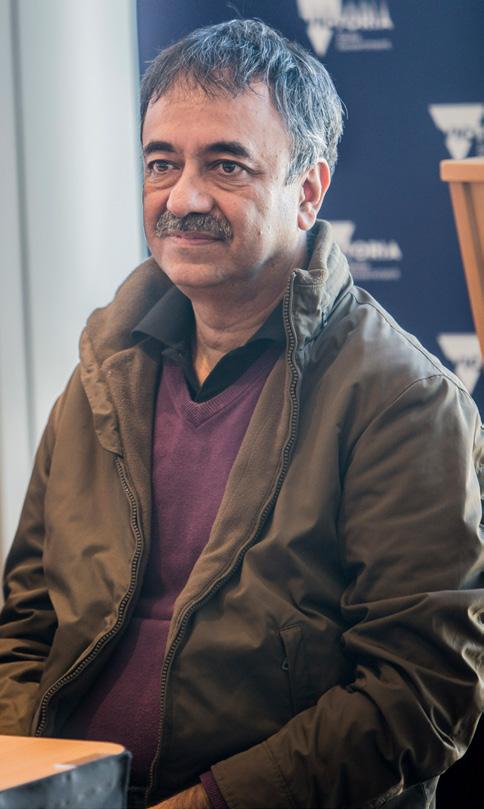
4 minute read
IFFM WHEN SANJU CAME TO MELBOURNE
from 2018-09 Brisbane
by Indian Link
Film-maker Rajkumar Hirani talks to PREETI JABBAL about his latest blockbuster, the ‘whitewashing’ rumours, and why we need more film festivals
He is known as Indian cinema’s most bankable director, a master craftsman and a creator with an intuitive Midas touch. It’s no wonder Rajkumar Hirani (of 3 Idiots, PK, Munnabhai MBBS and Sanju fame) won the IFFM 2018 Best Film and Best Director award. He talks to Indian Link about his latest offering Sanju, the controversial buzz surrounding it and of course, its reception at the festival.
Preeti Jabbal (PJ): Sanju has raised all sorts of interesting questions about the character and the interpretation. Have you achieved what you set out to achieve?
Raju Hirani (RH): When every film ends you always feel you could have done more. In hindsight, you wish that you could have done something differently, but finally it boils down to making choices due to limitations of time or restriction of budget. In Sanju, we talked about media using the guise of ‘our sources’ or sutron ke anusaar to get away with allegations and character assassinations. We focussed on the dreaded question mark that almost always goes unnoticed.
PJ: But the media is mum about the whole thing…
RH: It is hard when you turn the mirror around and they have to face it. I won’t make a sweeping statement and say everyone in the media is unethical, but the sad reality is that negativity sells and that’s what some people focus on to create news. After the release of Sanju the word ‘whitewash’ was thrown out there by some in the media and it stuck. We have been accused of whitewashing Sanjay Dutt’s story. But we clearly showed that he did drugs, he confessed to sleeping with over 300 women, he cheated with his best friend’s girlfriend and that he went to jail. So where is the whitewashing?
PJ: But people loved the film. And you even managed to reach out to the visually challenged. Did you have any role in achieving this?
RH: Yes of course they couldn’t have done it without my involvement. Saksham, the organisation behind this, had trialled something similar with my film PK but for DVD. This time, they managed to make it possible for the visually challenged to enjoy the movie in the cinema halls. You download an app, link it to the audio of the theatre and use your headphones. Plus, you get a visual description of the scenes. Like any new initiative, it will grow with time.
PJ: Coming now to Oz, do you think the Victorian government’s $3 million fund for Indian cinema will attract more artists?
RH: Melbourne is a fantastic city to shoot. It has a distinct character. And apart from the CBD there are some wonderful locations, like the Great Ocean Road. But there’s no denying that it’s expensive. I tried shooting here once but it was too costly an affair. The fund is a great initiative, but it’s not clear as to how they are going to distribute the $3 million. Usually, we get tax rebates when we shoot abroad. They offer free locations to shoot or reduce the taxes by 25% because the country attracts tourism. It’s a win-win.
PJ: Film festivals: what’s your opinion?
RH: The more, the merrier! Festivals are a great platform for films that aren’t commercially appealing or don’t boast of big stars. They are a great way to reach film lovers. I find that if movies get a good review in a festival, they get a better release. What Mitu Bhowmick Lange does with the Indian Film Festival in Melbourne is amazing. It may be easy to curate films, but bringing guests out from India is tough. I know how much effort she must be putting in to convince people to come here. We were here a few years ago when it was a much smaller event, now it is getting bigger and better.
PJ: What will it take for Bollywood to make a sizeable impact on the western world?
RH: I don’t think we should worry about that. People who are exposed to a certain milieu and culture make cinema. It’s not necessary that it will travel across the world and honestly, there is no harm if it doesn’t.
We make films for India. Americans, for example, have little exposure to India whereas we in India have more exposure to America. Generally, they tend to see the poverty and so movies like Slumdog Millionaire work. Maybe they are not yet able to associate with us.
PJ: Actors like Vicky Kaushal are becoming poster boys for a new wave of
Indian cinema. What are your thoughts?
RH: It’s not surprising. In fact, it reflects the intelligence of the audience. Back in the ‘80s, there was one (basic) formula on which multiple films were made. Sure there were great films too, like Ardh Satya, but they had limited audiences. Over the years, filmmakers have become bolder in their experiments, and people have become accepting of different genres of films. They like watching commercial cinema but they are also interested in contemporary movies or films that are based on out-of-the-box subjects.
PJ: On the personal front, what is your stabilising influence in this rapidly changing world?
RH: Not being judgemental or cynical helps, as our view of the world is completely made up of what we fill in our heads. The more we judge and are cynical, the more these stories will bother us, so it is important to remain sane.
PJ: Do you ever fear disappointing your fans, critics or even yourself?
RH: Yes. Whenever you make a film you want it to be accepted, you want your work to be loved, you want people to find resonance. With that expectation comes fear, but it is a good fear as it makes you strive for more.







